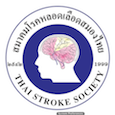Top of the Basilar Syndrome with Painful Palmar Reticulated Erythematous Patches Complicating Cardiac Atrial Myxoma: A Case Report
Keywords:
cardiac myxoma, embolism, stroke, erythematous patchAbstract
The authors reported an uncommon ischemic stroke in a young patient with an unusual dermatologic manifestation. A 28-year-old Thai woman presented with acute vertigo, ataxia, vertical diplopia, and impaired vertical gazes. Multiple painful, ill defined-border, reticulated, erythematous, and non-blanchable patches were formerly presented in both palms one day before the stroke onset. MRI showed hypersignals in bilateral thalami and left paramedian midbrain region on DWI with corresponding ADC map. Hyperechoic lobulated mass was detected at interatrial septum by transthoracic echocardiography. Top of the basilar syndrome with a rare skin sign were diagnosed and etiology was hypothesized as embolic phenomena caused by cardiac myxoma embolism. The dermatologic sign was exceptionally rare but the lesion can be a diagnostic clue for embolic mechanism caused by atrial myxoma.
References
Knepper LE, Biller J, Adams HP Jr, Bruno A. Neurologic manifestations of atrial myxoma. A 12-year experience and review. Stroke 1988;19:1435–1440.
Barkhof F, Valk J. “Top of the basilar” syndrome: a comparison of clinical and MR findings. Neuroradiology. 1988;30:293-298.
Silverman IE, Geschwind MD, Vornov JJ. Cerebellar top-of-the-basilar syndrome. Clin Neurol Neurosurg. 1998;100:296-298.
Finocchi C, Del Sette M, Croce R, Giberti L, Serrati C, Gandolfo C. Bilateral ophthalmoplegia: an unusual sign of the top of the basilar artery syndrome.
Ital J Neurol Sci. 1996;17:301-304.
Usón-Martín M, Gracia-Naya M. Top of the basilar artery syndrome: clinico-radiological aspects of 25 patients. Rev Neurol. 1999;28:698-701.
Vezzosi D, Vignaux O, Dupin N, Bertherat J. Carney complex: clinical and genetic 2010 update. Ann Endocrinol. 2010;71:486-493.
Reed OM, Mellette JR, Fitzpatrick JE. Cutaneous lentiginosis with atrial myxomas. J Am Acad Dermatol 1986;15:398-402.
Praitano ML, Tamburin S, Pederzoli L, Zanette G. Recurrent transitory ischaemic attacks with skin lesions, arthralgia and myalgia should prompt suspicion of atrial myxoma. J Neurol Neurosurg Psychiatry 2010;81:302-303
Reynen K. Cardiac myxomas. N Engl J Med 1995;333:1610–1617.
Spengos K, Wohrle JC, Tsivgoulis G, Stouraitis G, Vemmos K, Zis V. Bilateral paramedian midbrain infarct: an uncommon variant of the “top of the basilar” syndrome. J Neurol Neurosurg Psychiatry. 2005;76(5):742-3.
Downloads
Published
How to Cite
Issue
Section
License
ข้อความภายในบทความที่ตีพิมพ์ในวารสารสมาคมโรคหลอดเลือดสมองไทยเล่มนี้ ตลอดจนความรับผิดชอบด้านเนื้อหาและการตรวจร่างบทความเป็นของผู้นิพนธ์ ไม่เกี่ยวข้องกับกองบรรณาธิการแต่อย่างใด การนำเนื้อหา ข้อความหรือข้อคิดเห็นของบทความไปเผยแพร่ ต้องได้รับอนุญาตจากกองบรรณาธิการอย่างเป็นลายลักษณ์อักษร ผลงานที่ได้รับการตีพิมพ์ในวารสารเล่มนี้ถือเป็นลิขสิทธิ์ของวารสาร





